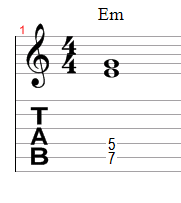Devil Is In The Dyad, 2 Note Potential |
|
|
|
|
|
| Feb 26 2015, 07:49 PM |
|
The Devil is in the Dyad
Some of you may remember one of my lessons from way back in history, when the Romans still had their empire. That lesson is The Devil is in the Diad. Turns out, I spelt the word dyad wrong ! Duh ! Anyway, a dyad is something you've probably already been using anyway but let's take a look at them. A dyad is a grouping of 2 notes. Essentially a 2 note chord. http://en.wikipedia.org/wiki/Dyad_(music) It could consist of root+5th, which we would usually refer to as a power chord. Many people would include the octave in a power chord to make it 3 notes but many people use the 2 note version. Anyway, forget the root+5th a moment because things get a bit juicier when we start putting together a root+3rd combination. These are lovely little critters that are perfect for moving around the neck. I've composed many a riff around these shapes and a lot of songs in metal make use of these bad boys: The main riff in The Zoo by Scorpions makes use of dyads in the key of Em. Check it out from 0:37 onwards. That's also a totally badass crunch as well. Marshall + Gibson. Enough said. The main riff in this track by the Filth, starting at 1:36. Killer chord progression, I love it. Declaration Day by Iced Earth demonstrates one of the coolest and most popular melodic sounds in metal, the change from root+5th to root+augmented 5th (or minor 6th). You can also see first hand how easy it is to move these shapes around the neck and it still sounds large. My first question to you is, if you're not using these shapes already, why ? Get on it ! If you want some ideas on how to find these dyads then look no further than the scale you're using. If you want to compose something in the key of Em then get the GMC Scale Generator fired up if you need a reminder on what the intervals for the Em scale are. Try this: Play through the Em scale using dyads. Start on root + minor3rd on the following position:  From there move to the next intervals in the scale. So, for the A string, you'd move a whole tone to F# on the 9th fret. For the finger on the D string you will just need to review what intervals are in the scale and move up to the next one. Repeat this process through the scale and you will find yourself playing through a progression of minor and major dyad shapes. My second question is what songs can you think of that use dyads ? Share some examples here. |
|
|
||
Posts in this topic
 Ben Higgins Devil Is In The Dyad Feb 26 2015, 07:49 PM
Ben Higgins Devil Is In The Dyad Feb 26 2015, 07:49 PM
 klasaine In jazz, especially for guitar players, two note c... Feb 28 2015, 04:50 PM
klasaine In jazz, especially for guitar players, two note c... Feb 28 2015, 04:50 PM
 tonymiro as Ken says it's used a huge amount in jazz. A... Feb 28 2015, 07:04 PM
tonymiro as Ken says it's used a huge amount in jazz. A... Feb 28 2015, 07:04 PM
 Ben Higgins If it's used in jazz, then you know it's g... Feb 28 2015, 09:02 PM
Ben Higgins If it's used in jazz, then you know it's g... Feb 28 2015, 09:02 PM

 klasaine QUOTE (Ben Higgins @ Feb 28 2015, 12:02 P... Mar 1 2015, 05:48 PM
klasaine QUOTE (Ben Higgins @ Feb 28 2015, 12:02 P... Mar 1 2015, 05:48 PM
nnn

 tonymiro Sorry Ben I haven't seen it yet either. Mar 2 2015, 03:00 PM
tonymiro Sorry Ben I haven't seen it yet either. Mar 2 2015, 03:00 PM
 klasaine Here's a cool example of dyads in a tune.
Note... Mar 2 2015, 03:55 PM
klasaine Here's a cool example of dyads in a tune.
Note... Mar 2 2015, 03:55 PM
 tonymiro Am I right in thinking that Lenny Breau pretty muc... Mar 2 2015, 06:30 PM
tonymiro Am I right in thinking that Lenny Breau pretty muc... Mar 2 2015, 06:30 PM
 klasaine I don't know if he pioneered them. There's... Mar 2 2015, 08:57 PM
klasaine I don't know if he pioneered them. There's... Mar 2 2015, 08:57 PM
nnn
nnn
1 User(s) are reading this topic (1 Guests and 0 Anonymous Users)
0 Members:
















